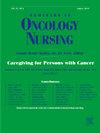Cross-Lagged Panel Network Analysis of Symptoms in Patients with Gastric Cancer Undergoing Postoperative Chemotherapy
IF 2.3
4区 医学
Q1 NURSING
引用次数: 0
Abstract
Objectives
To develop temporal symptom networks at three postoperative chemotherapy time points and investigate the longitudinal relationships between 18 symptoms in patients with gastric cancer undergoing postoperative chemotherapy in China.
Methods
Symptom prevalence and severity were measured using the M. D. Anderson Symptom Inventory (MDASI) and Gastrointestinal Cancer Module of the MDASI (MDASI-GI) at T1, T2, and T3 on the day after the first, third, and sixth chemotherapy sessions, respectively. Cross-lagged panel network (CLPN) models were employed to examine the temporal dynamics of the 18 symptoms and their interrelationships.
Results
In total, 379 participants were included. Dry mouth had the highest out-prediction (r = 0.101) and out-strength (r = 0.863) values during T1→T2. The strongest direct effect was observed for the change in taste → lack of appetite (β = 0.38) during T2→T3. Feeling bloated had the highest values for out-strength (r = 0.910), out-prediction (r = 0.215), and bridge strength (r = 1.010) during the T2→T3 period. The two CLPNs showed medium to high stability based on the centrality stability coefficients of out-strength and in-strength.
Conclusions
Lack of appetite can be improved during chemotherapy by managing vomiting and taste changes. Attention should be paid to the dry mouth and feeling bloated, as they are the strongest predictors in the early and middle stages of treatment.
Implications for Nursing
Understanding the relationship between symptoms during chemotherapy in patients with postoperative gastric cancer can help clinicians identify targets for intervention at different times.
胃癌术后化疗患者症状的交叉滞后面板网络分析
目的:建立胃癌术后化疗3个时间点的时间症状网络,探讨中国胃癌术后化疗患者18种症状之间的纵向关系。方法:分别于第一次、第三次和第六次化疗后的第1、2、3天,使用md安德森症状量表(MDASI)和MDASI胃肠癌模块(MDASI- gi)测量症状的患病率和严重程度。采用交叉滞后面板网络(CLPN)模型来检验18种症状的时间动态及其相互关系。结果:共纳入379名受试者。在T1→T2阶段,口干的预测输出值(r = 0.101)和强度输出值(r = 0.863)最高。直接影响最大的是T2→T3期间味觉变化 → 食欲不振(β = 0.38)。在T2→T3阶段,感觉肿胀的强度(r = 0.910)、预测强度(r = 0.215)和桥梁强度(r = 1.010)值最高。根据外强度和内强度的中心性稳定性系数,两种clpn均表现出中至高的稳定性。结论:化疗期间食欲不振可通过控制呕吐和味觉变化得到改善。应注意口干和感觉肿胀,因为它们是治疗早期和中期最强的预测因素。对护理的启示:了解胃癌术后患者化疗期间症状之间的关系,有助于临床医生在不同时期确定干预目标。
本文章由计算机程序翻译,如有差异,请以英文原文为准。
求助全文
约1分钟内获得全文
求助全文
来源期刊

Seminars in Oncology Nursing
Nursing-Oncology (nursing)
CiteScore
3.40
自引率
0.00%
发文量
68
审稿时长
45 days
期刊介绍:
Seminars in Oncology Nursing is a unique international journal published six times a year. Each issue offers a multi-faceted overview of a single cancer topic from a selection of expert review articles and disseminates oncology nursing research relevant to patient care, nursing education, management, and policy development.
 求助内容:
求助内容: 应助结果提醒方式:
应助结果提醒方式:


